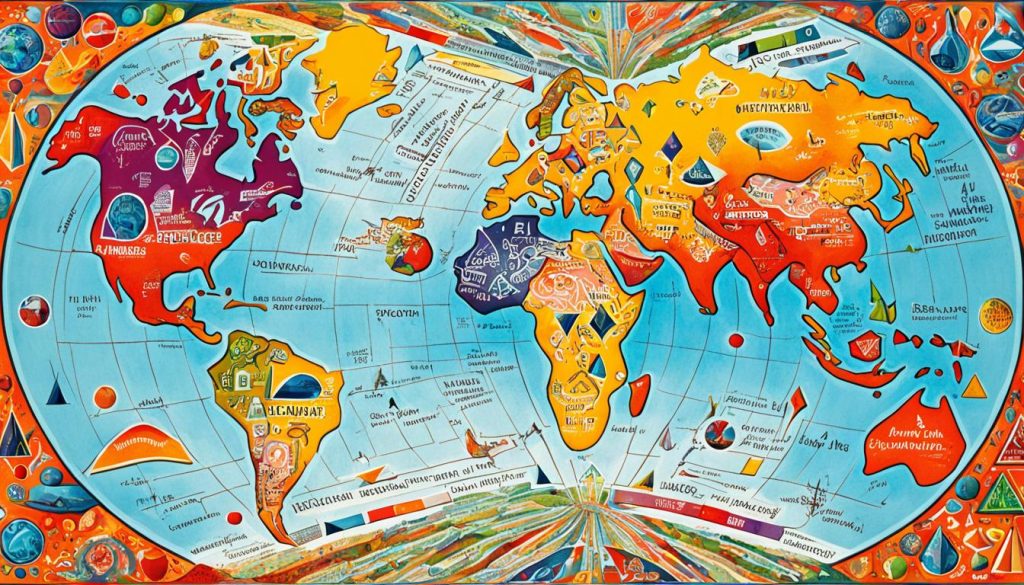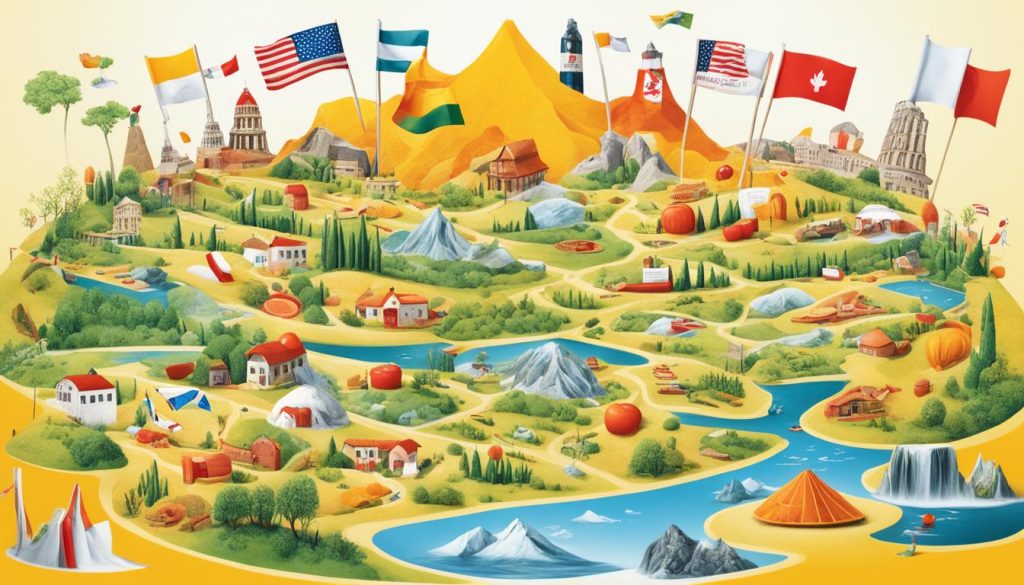Sitting here, pen in hand, I think about the struggles of effective communication. I remember my own challenges with language and culture. I’ve faced these in the boardroom, with international mates, and diverse clients. It showed me how big language barriers’ effects can be on our connections and success.
In today’s global business world, talking clearly with others is key. But, issues like languages divides and differences in how people communicate can get in the way. Especially as firms hire from around the world and enter new markets. In this piece, we’ll look into why language barriers happen, the issues they bring, and how to beat them. The aim is to build better understanding and communication despite cultural differences.
What are Language Barriers and Communication Differences?
Language barriers can cause confusion or stop us understanding each other when we talk. This happens when people speak different languages. But, it’s not just about talking in different languages.
It’s also about different abilities in a language, how we say things (accents and slang), and using technical words. All these things can get in the way of a clear talk.
Understanding Language Barriers
Language barriers start because of how people speak and understand. Sometimes we don’t get the meaning behind words because of our language skills or different cultural ideas. This makes it hard to really understand each other.
Linguistic Variations and Cultural Nuances
Aside from just speaking different languages, there are other issues. Like if we use different dialects, special words, or if our communication style is very different. These things can also make it hard for us to really connect when we talk.
For instance, regional speech differences (dialects) can make communication tough, even if we’re speaking the same base language. And, using words that only some people know, or relating to cultural habits, can create communication barriers too.
Dealing with these language and cultural differences is key to making better communication. Organisations need to understand how their people like to talk, so they can all work together well.
Language Barriers and Communication Differences
Language barriers often come up because people speak different languages or dialects. This can make talking to each other hard. Even simple talks might not work if people can’t understand each other. Regional dialects of a language can add to the problem. They cause misunderstandings and stop teams from working well together.
Spoken Languages and Dialects
When people speak different languages or dialects, they might not understand each other. This can lead to confusion and make it hard to work together on the same goals. Regional ways of speaking can make this even more difficult. People who speak the same base language may still have trouble communicating.
Technical and Industry-Specific Jargon
Technical words or phrases from different fields can be hard for others to grasp. Specialised knowledge sometimes needs complex terms. But if not everyone understands, it creates barriers to working together. Overcoming these language differences is key to clear communication throughout the organisation.
Accents and Regional Variations
Accents make it tough too. They’re unique ways of saying words. Even if you speak the same language, accents can cause misunderstandings. It’s important to understand and adjust to these different speech patterns. This helps make conversations clear and easy to follow.
Challenges Posed by Language Barriers
Language barriers can make it hard for organisations to share information properly. This leads to many problems. Employees find it tough to tell their bosses what they need or to give good feedback. It also makes it hard to work well with customers and suppliers, affecting the service quality.
Miscommunication and Lost Messaging
Miscommunication hurts how well a team works together. Staff might not clearly express their needs or feedback to their managers. This can make it difficult to keep clients happy and work well with suppliers.
Strained Professional Relationships
Not speaking the same language can cause big problems. Without clear communication, teams and partners might not meet deadlines or understand each other. Good communication is key to keeping everyone on the same page.
Compromised Quality of Service
If those who deal with customers don’t understand each other, the service can suffer. This could lead to losing sales and upset customers. Talking clearly with clients is vital to keep them happy and protect the company’s image.
Cultural Differences and Communication Styles
Differences in how we communicate can make talking hard, apart from language differences. Some places are known as “high context” cultures. Here, people use a lot of hidden cues and shared understandings to talk. In contrast, “low context” cultures are more used to clear and direct talk.
It’s important to understand these differences. This understanding helps us talk better and understand each other more easily.
High and Low Context Cultures
In high context cultures, people look at the bigger picture and use things like body language and assumptions to talk. On the other hand, those in low context cultures like to say things directly.
Knowing about these different styles can make cross-cultural talks smooth. Without this knowledge, we might misunderstand each other.
Nonverbal Communication Cues
Nonverbal communication can change a lot from culture to culture. Things like body stance, actions, and eye contact might mean different things. Something friendly in one place could feel rude somewhere else.
If we don’t learn about these differences, we might make mistakes. These mistakes can stop us from talking well with people from other cultures.
Overcoming Language Barriers in the Workplace
To tackle language barriers at work, clear and simple communication is key. It’s important to avoid using technical words and complicated terms. This approach ensures everyone, no matter their language, understands what’s being said. By using easy words, work teams can really understand each other better.
Clear and Concise Communication
Clear and simple talks help to connect where language divides us. Encouraging the use of easy words and avoiding complex terms makes messages understandable. This boosts teamwork and makes work more effective for all.
Embracing Cultural Intelligence
To get past language hurdles, cultural understanding is crucial. This means knowing and respecting how people from different places talk. It helps to make everyone feel they can speak up and be heard, no matter their language.
Professional Translation Services
Using pro translation services is a big help in breaking language barriers. Skilled translators ensure that important info is clear in any language. Also, using tech to translate and adapting products for different markets is vital.
The Impact of Language Barriers on International Marketing
Language barriers greatly affect a company’s global marketing. Moving into new markets needs careful planning. This includes translating and adapting content, packaging, and messages for the new audience’s culture.
Failing to do this can cause misunderstandings and offend the local culture. It could result in a bad experience for the new customers.
Product Localisation
Good product localisation is key for selling globally. To do it well, companies must really know their new market. They should use professional translators to avoid mistakes in their messages.
Adapting to local tastes, like using friendly idioms and familiar visuals, makes the product appealing. This way, companies offer a smooth experience to people worldwide.
Cross-Cultural Advertising
Creating ads that work in different cultures is a fine art. Marketers must understand and respect varied traditions and languages. They need to make ads that are funny, attractive, and meaningful to all.
This means adjusting the language and visual elements to fit each culture. With this approach, companies build marketing that speaks to everyone in a personal way.
Role of Leadership in Bridging Communication Gaps
Leaders have a key role in getting past communication gaps and language hurdles within their teams.
They do this by making their workplace welcoming to all, embracing diverse cultures, and valuing the spectrum of unique voices. Leaders inspire their staff to respect various ways people communicate. They offer help for learning new languages and understanding different cultures. This makes the team more united and empathetic to each other.
Fostering an Inclusive Environment
Making the workplace inclusive is vital for smashing through language barriers. Leaders must push for people to be aware of different cultures. They encourage sharing of different viewpoints and ensure that everyone, no matter what they speak, feels like they can be part of the team’s success.
Effective Cross-Cultural Training
Leaders should also arrange for solid cross-cultural training. These sessions can boost understanding of others’ cultures, improve how we talk to each other, and give us the skills needed to work well, even when language is a challenge. By offering this training, leaders sharpen their team’s ability to work together across borders. They help their organisation stand out in the world market.
Language Barriers and Globalisation
As organisations grow globally, they hire from many countries. This leads to more language barriers. Creating a multilingual workforce is key. Such teams can speak many languages, helping to overcome these challenges. But it’s important to also support language diversity among employees. This means giving them the help they need to learn and use multiple languages.
Multilingual Workforces
Having a team that speaks many languages is a big advantage today. It helps companies deal with the complexities of hiring and managing global talent. By providing language training and celebrating language diversity, businesses can make their teams stronger. This way, employees can work better together across different languages. And this can lead to more creativity and better teamwork.
Remote and Virtual Teams
With more remote work and virtual teams, language issues have become even more critical. Team members are often in different places, talking through digital tools. This can lead to misunderstandings. To fix this, companies should use the best communication technology. This helps everyone work together smoothly, no matter their location or language.
Strategies for Improving Cross-Cultural Communication
Learning to communicate across different cultures is vital in today’s world. Active listening is key. It means really trying to understand what someone is saying – the words they use, their culture, and the deeper meaning.
Through active listening, we not only hear but understand. We ask for more clues to the conversation if we don’t get it. This way, we can start to really talk and work with people from other cultures.
Active Listening
Active listening means listening with your ears and your heart. It’s about more than just hearing the words. It’s about understanding the person and their point of view. By watching how someone talks or moves, you get more clues about what they really mean.
Seeking Clarification
In dealing with language gaps, it’s important to ask when you don’t understand. Everyone should be encouraged to ask questions. This helps make sure everyone gets the right message. A workplace that supports open talks helps tackle these challenges better.
Building Shared Understanding
Breaking language barriers aims to make everyone understand each other. It’s about trying to be aware of each other’s cultures and feelings. Working together on problems also helps.
This means being open to learn about others and working with them. This way, companies and teams can work better with their diverse staff and customers.
Harnessing Technology to Overcome Language Barriers
Technology has opened new ways to beat language barriers. Machine tools and live interpretation make talking in different tongues easier. This tech lets everyone communicate better, no matter the language, making everything more efficient and open-minded.
Machine Translation and Interpretation Tools
Machine tools for translations and instant interpreters have gotten much better. They’re a big help in breaking down language walls. People can talk in their own language and still be clearly understood. This is great for making everyone feel part of the conversation, improving teamwork, and delighting customers worldwide.
Video Conferencing and Collaboration Platforms
Then there’s video calls and online teamwork tools. They’re key for teams that aren’t all in the same place. These tools bring a face and shared projects to the conversation. It makes up for missing each other’s verbal hints due to language differences. This way, working together becomes smoother, more interesting, and fairer, no matter where team members are located.
Language Learning and Professional Development
Investing in continuous language training and professional development is key. It helps to build a stronger and more skilled workforce. Organisations offer language classes and immersion programmes. This empowers their teams to learn new languages. It also improves their ability to communicate across cultures.
Continuous Language Training
Organising continuous language training is very important. It helps employees keep improving their language skills. This is vital for working well in a multilingual setting.
This training also deepens their understanding of different cultures. It makes them better at communicating and working with others from around the world.
Language Immersion Programs
Sending employees on language immersion programs abroad is very beneficial. It helps overcome language barriers. These programs are not just about improving language skills.
They offer a chance for employees to experience new cultures and places. This global exposure and exchange of cultures are great for their career growth. It also helps them succeed in workplaces with many languages and cultures.
Case Studies: Language Barriers in Global Organisations
Real-world case studies show how global organisations tackled language barriers. They offer insights and lessons for other companies. These studies look at the challenges faced, the strategies used, and the outcomes seen. It’s a practical way to understand the principles in this article.
Take the case of Unilever, a big consumer goods company. They operate in over 190 countries. Language differences made teamwork and productivity tough. Unilever then set up a big language training scheme. This gave staff language classes and chances to practice. The result? Better communication across cultures, more involved staff, and a boost in project efficiency.
Airbus also faced language problems as it grew globally. Their engineers and project managers were finding it hard to understand each other. So, Airbus brought in high-tech translation and interpretation tools. This let everyone talk in their own language during work. These tools made Airbus work better together, cut mistakes, and get planes to customers sooner.
Nestlé, a big food and drink company, had its own issues. Their marketing teams struggled to connect with people in different countries. This often led to misunderstanding and hurt feelings. Nestlé found a better way to adapt their campaigns to local cultures. They hired professional translators and advisors. This increased their marketing success and sales around the world.
These examples show that tackling language hurdles takes different approaches. From teaching staff to using smart tools, every effort counts. Clear communication, an open and respectful workplace, plus the right technology can make a big difference. This way, companies can fully use their global teams and meet the needs of their customers worldwide.
Building a Multilingual and Culturally Competent Workforce
Creating a workforce that understands many languages and cultures is key. It helps tackle language hurdles and improve cross-cultural chats. Businesses need to push for varied and fair practices. They should support different languages, offer language lessons and explain cultures. This way, workers can freely exchange their unique viewpoints and the way they speak.
Diversity and Inclusion Initiatives
Companies should push for programs that highlight the beauty of speaking various languages. This includes organizing language lessons and sharing different cultures. They should also create a workplace that respects the various skills and ways of talking of its workers.
Language and Cultural Mentorship Programs
Having programs where skilled workers act as mentors is highly beneficial. They match those fluent in several languages with those eager to learn more. This promotes sharing skills and culture. It also boosts the ability to work together despite different cultural backgrounds.
Companies gain a lot when they help employees grow and create an inclusive space. Not only does this improve how everyone in the company talks and works together, but it also makes it easier to deal with customers and partners worldwide.
Future Trends: Navigating Language Barriers in an Interconnected World
Globalisation is making the world more connected. This makes it vital for companies to deal with language barriers effectively. They need to watch for new trends, like more demand for those who speak many languages. Plus, they’ll need to use technology for translation more and learn new ways to talk across cultures.
The future work world will have more languages than ever. Companies aim to have teams who understand global markets well. They’ll use tech that translates on the spot, making it easier to work with people worldwide.
Covid-19 pushed us more towards working from far away. This makes good communication even more critical, without face-to-face chats. Companies need to use the best tech out there to talk without issues, no matter the language. This keeps everyone on the same page and working well together.
Being ready for these big changes will help companies do well in a world that uses many languages. Taking on the challenges of language barriers will give them an edge, help with new ideas, and make strong bonds with people worldwide.















